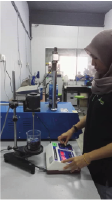
Methylene Blue Value Test
The Methylene Blue Value (MBV) Test determines the presence of hazardous clay minerals in fine aggregates, particularly manufactured or crushed sand. The test, which is carried out in accordance with EN 933-9 and AASHTO T330, determines the quantity of adsorptive clays by measuring how much methylene blue dye the aggregate fines absorb. These clay particles can severely interfere with the bonding of cement paste and aggregates, resulting in decreased concrete strength and greater shrinkage. The MBV test is critical for determining aggregate purity, especially in places where natural sand is limited and manufactured alternatives are employed. Low methylene blue levels help to generate durable, stable concrete and asphalt mixes that are less prone to cracking and moisture damage.
Advantages of Methylene Blue Value Test:
- Identifies hazardous clay content in fine aggregates.
- Improves the bonding and mechanical strength of concrete.
- It prevents excessive shrinkage and cracking.
- Essential for produced or crushed sands.
- Increases the endurance and lifetime of constructions.







 US 28279
US 28279  BR 24108
BR 24108  GB 16861
GB 16861  CA 9770
CA 9770  AU 9718
AU 9718  IN 6302
IN 6302  IE 4568
IE 4568  NZ 4437
NZ 4437 

